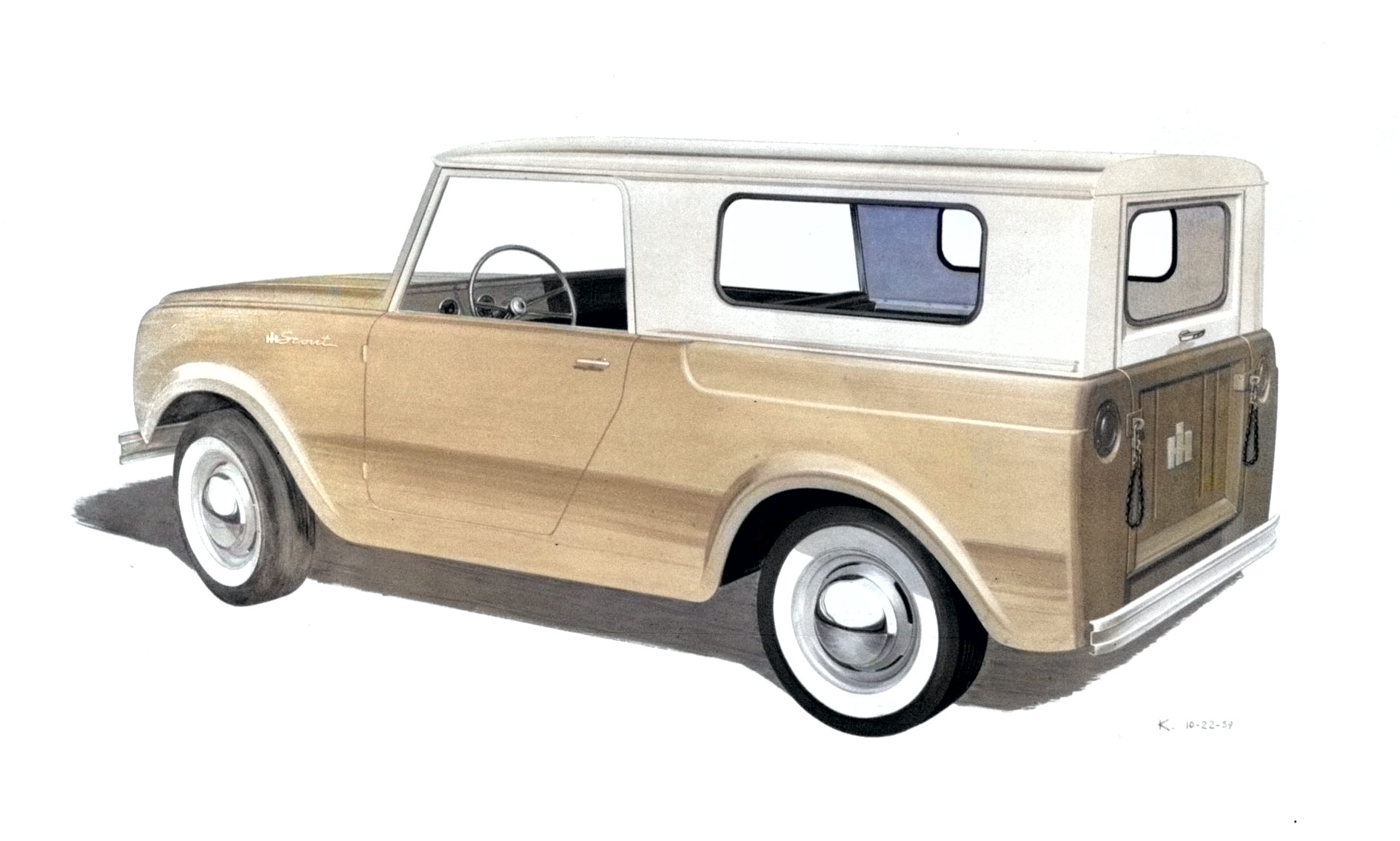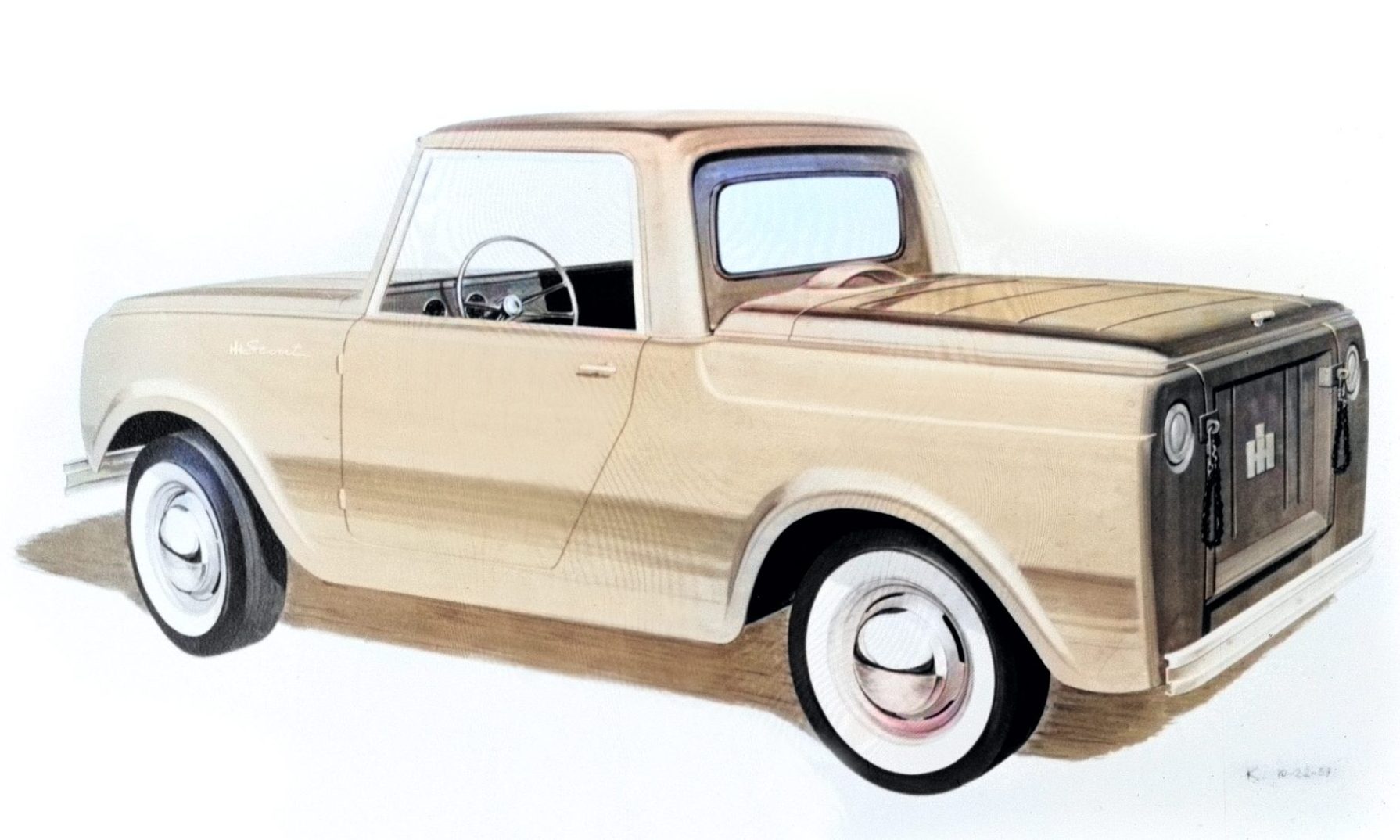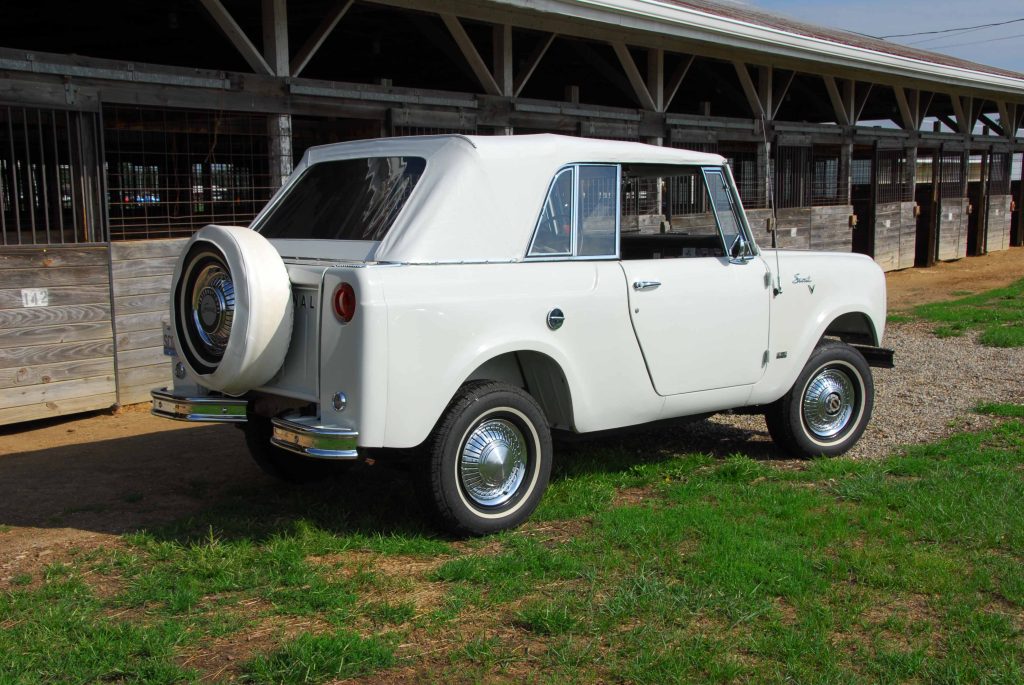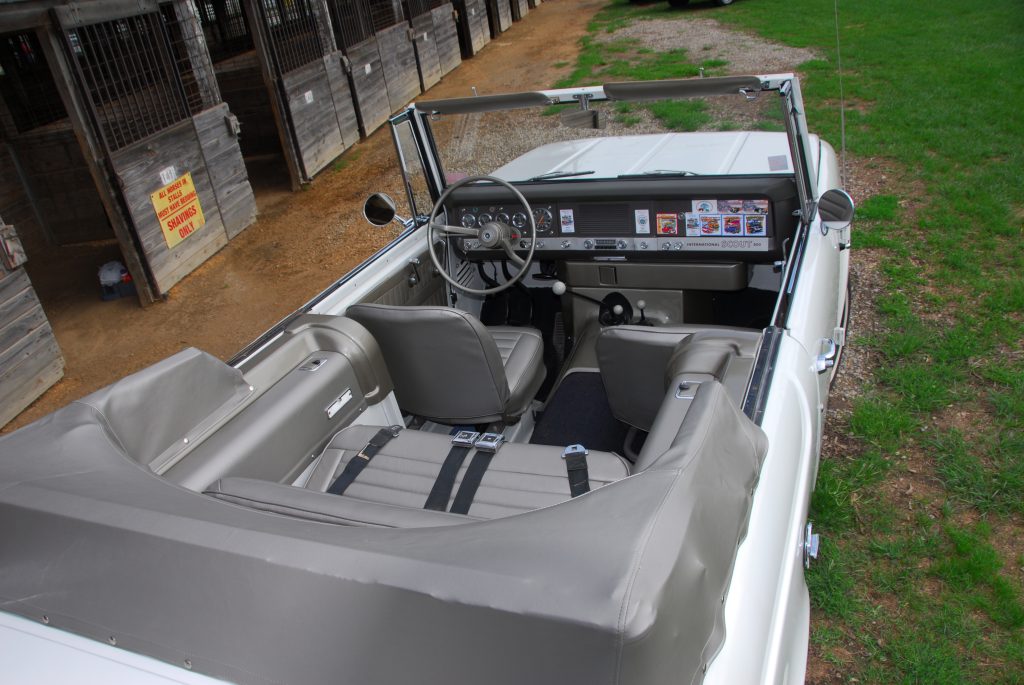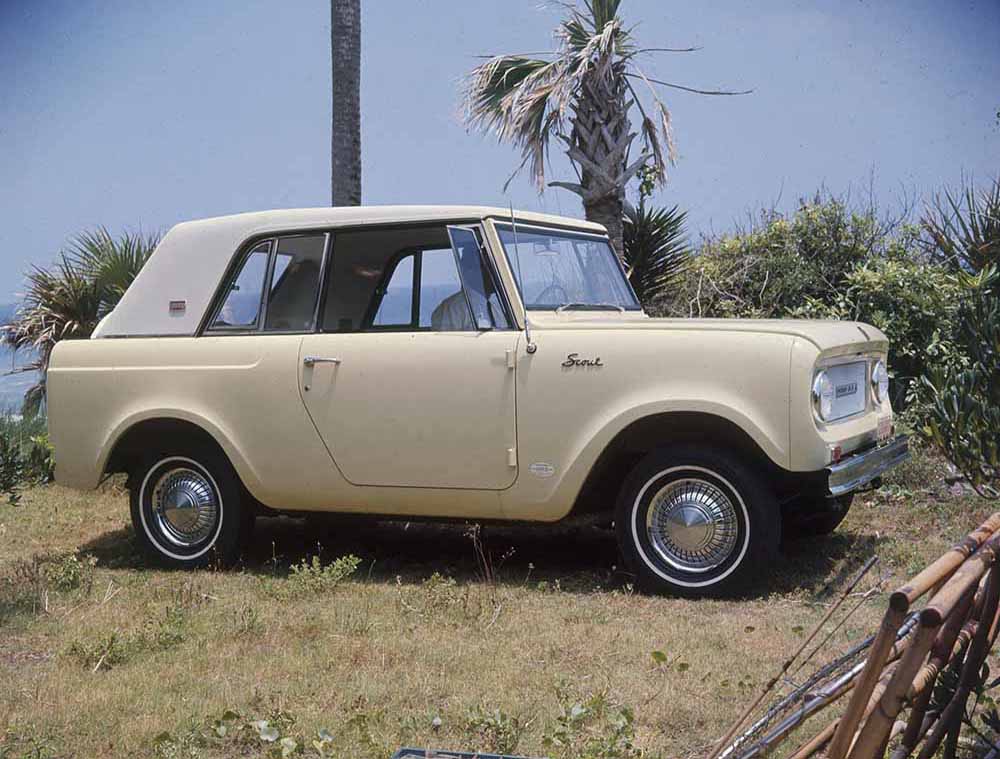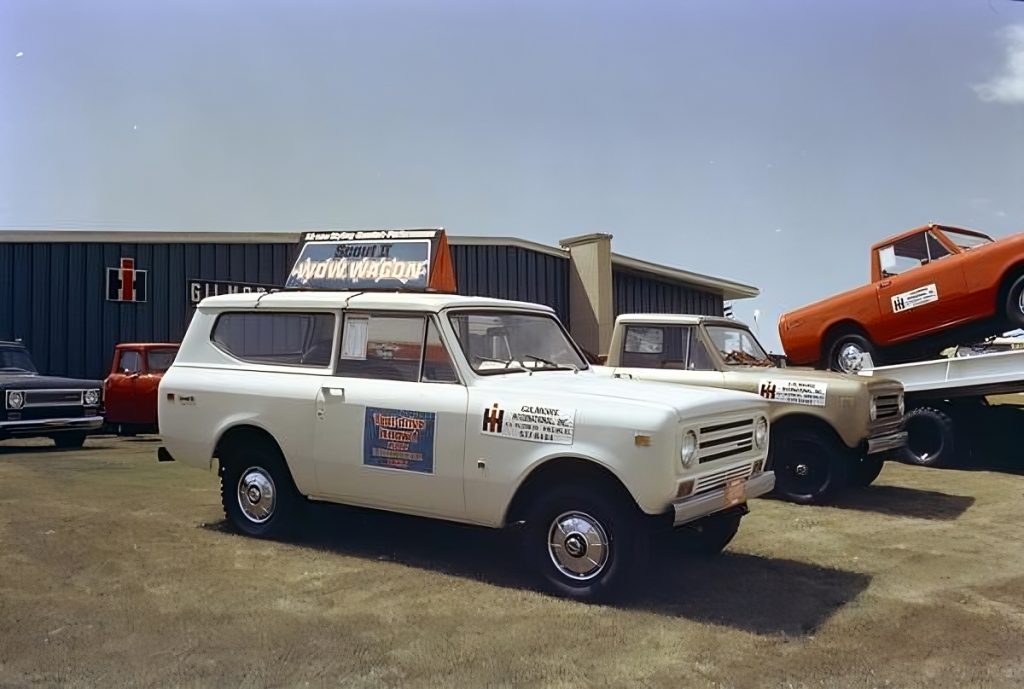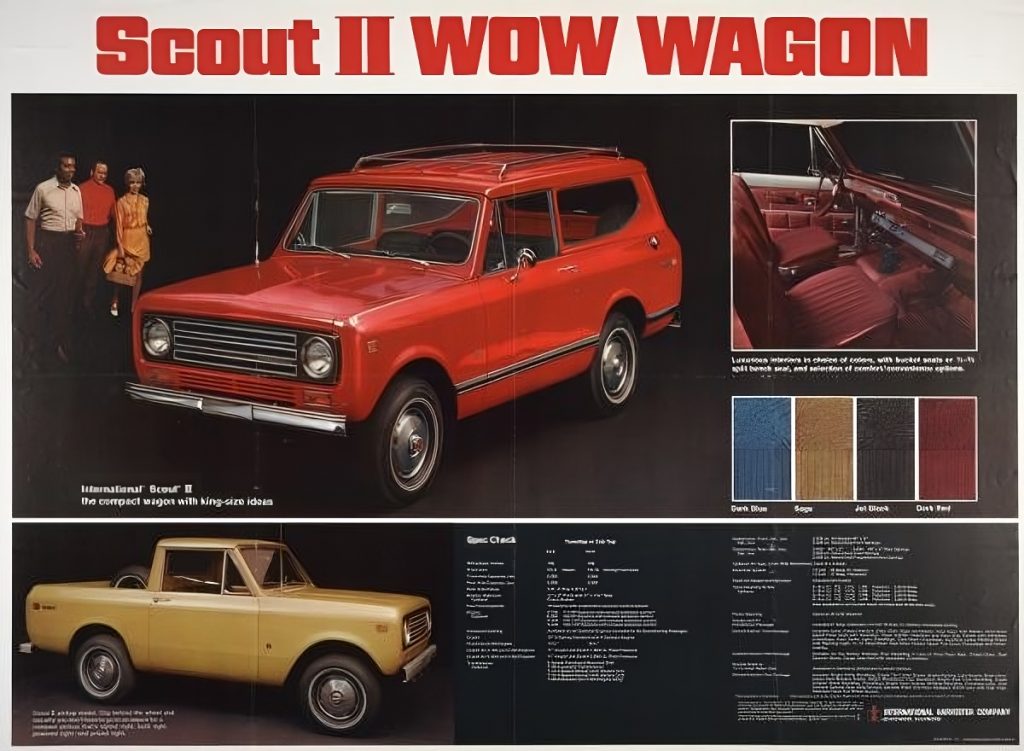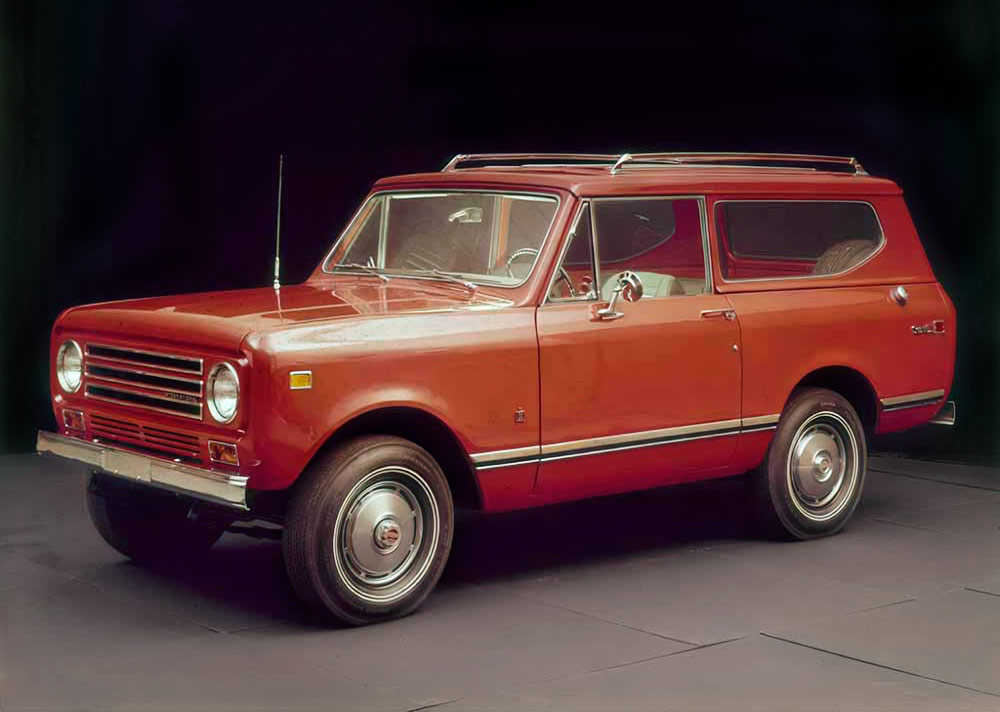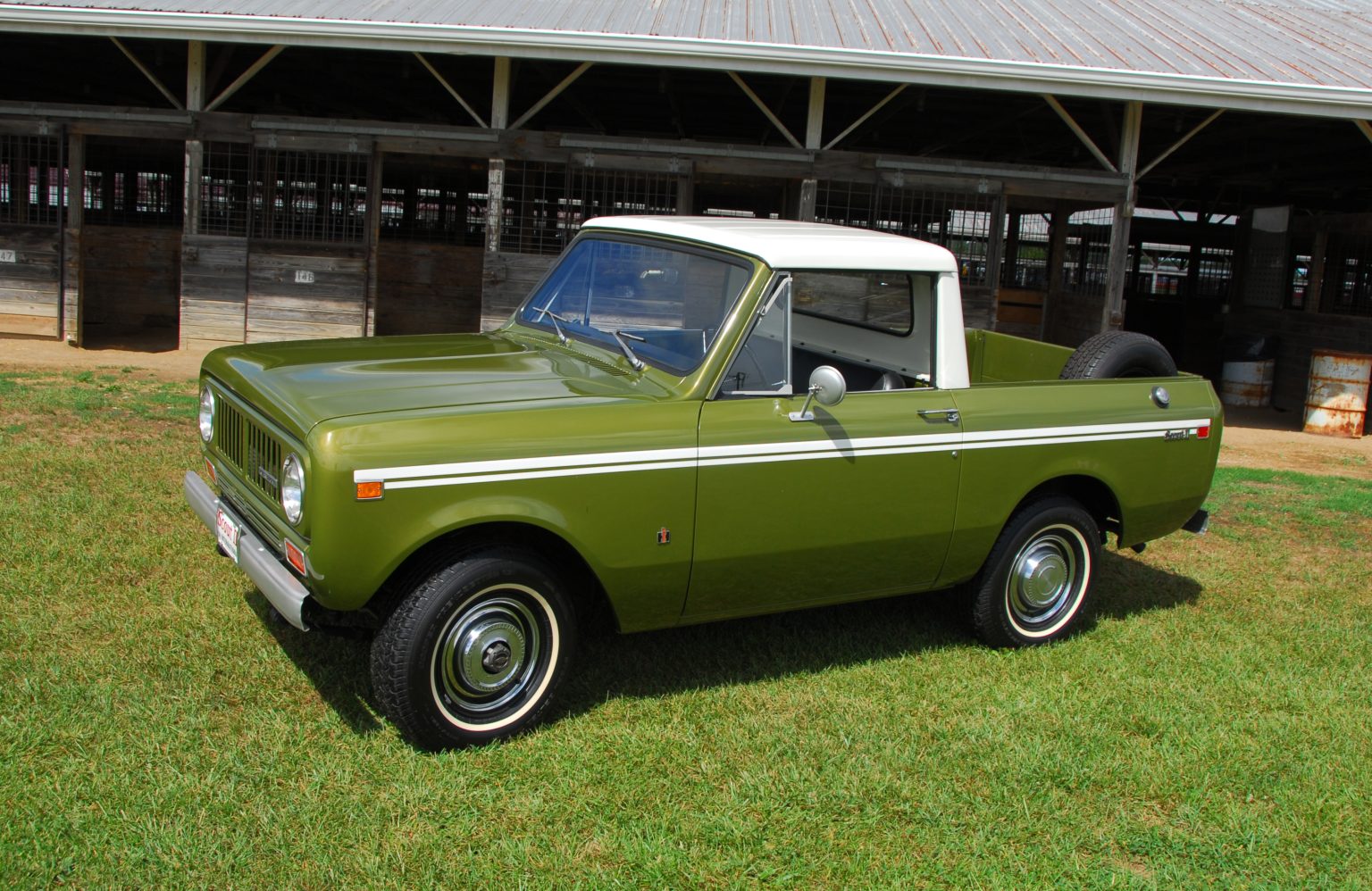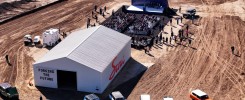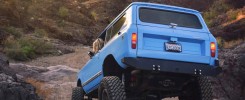SCOUT: THE UNEXPECTED SUCCESS
By: Jim Allen
(ABOVE) From February of 1959 here’s a rendering from stylist Chuck McGrew that shows the Scout in it’s early compact pickup for with a Royalite body. This general design would be refined to the point of a scale model. By that time, the Royalite idea was moments away from being scrapped. This was before the trademark rights to Scout had been secured and most of the IH stylists were using “Scouter” as a working name. Ornas Family Collection
(ABOVE) When the head of the IH Motor Truck Division speaks, the Styling Department listens. Ralph Buzard commented about making deliveries more safe and the styling department got right to work. The productive Krippendorf penned a hard tonneau idea as well as a full-length hardtop. The hardtop was chosen for production but wasn’t actually approved until April of 1960, not leaving much time before the December launch to build the tooling.
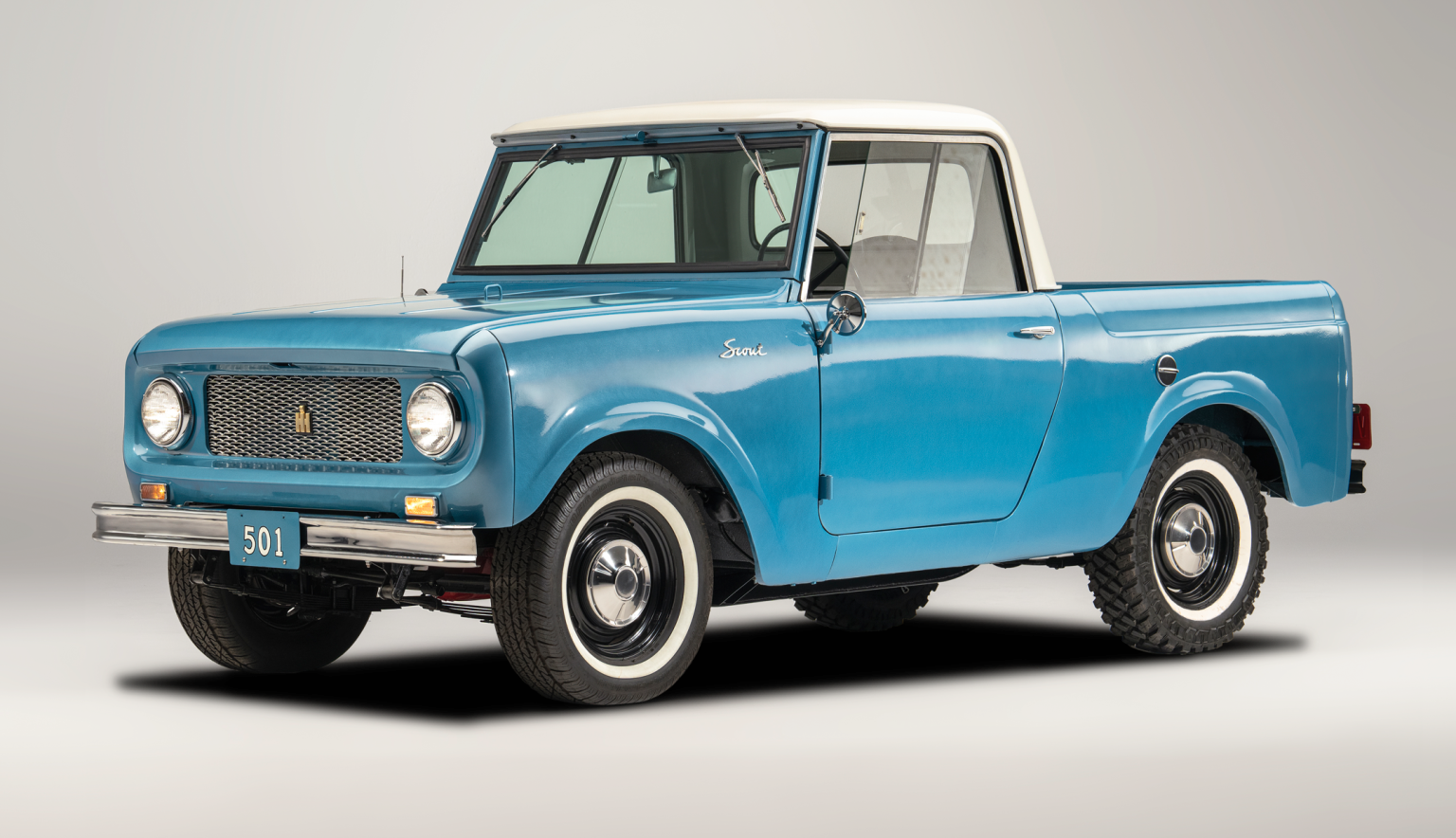
The first Scout, FC501, in all it’s resurrected glory. This is largely how it rolled off the line December 1, 1960, a 4×2 Cab-Top in Blue Metallic livery. It was given a few non-standard accoutrements at birth, including the chromed bumpers and mirrors. Like many of the first Scout 80s, it was retained for a short period as a testbed and to use in PR duty. In case you are wondering, it was long-standing IH tradition to start sequentially numbered products at 501. The “FC” indicated Fort Wayne Works, “C” assembly line. FC501 was sold to an employee sometime in 1961 and did its Scoutlike duty as a private citizen. When rust finally got the better of it, FC501 languished until discovered by noted Scout Guru and parts supplier Phil Coonrod. Phil says he was waiting for “The Right Time” to restore it. The universe aligned in 2019 and a dedicated group volunteers banded together to restore the truck. Sadly a lot of parts were missing or so totally rusted to be beyond repair, so this resurrected unit is only about 15 percent the original Scout… but that includes the serial numbered chassis. With great effort, the missing and unique early production parts were found. and FC501 was slowly made whole. It debuted at the 2023 Harvester Homecoming annual event and it’s hoped FC501 can be a cornerstone of a new museum celebrating the Fort Wayne Works, where almost all of International’s Heavy trucks were built as well as Scout. If you’d like to help with that, go to https://harvesterhomecoming.com
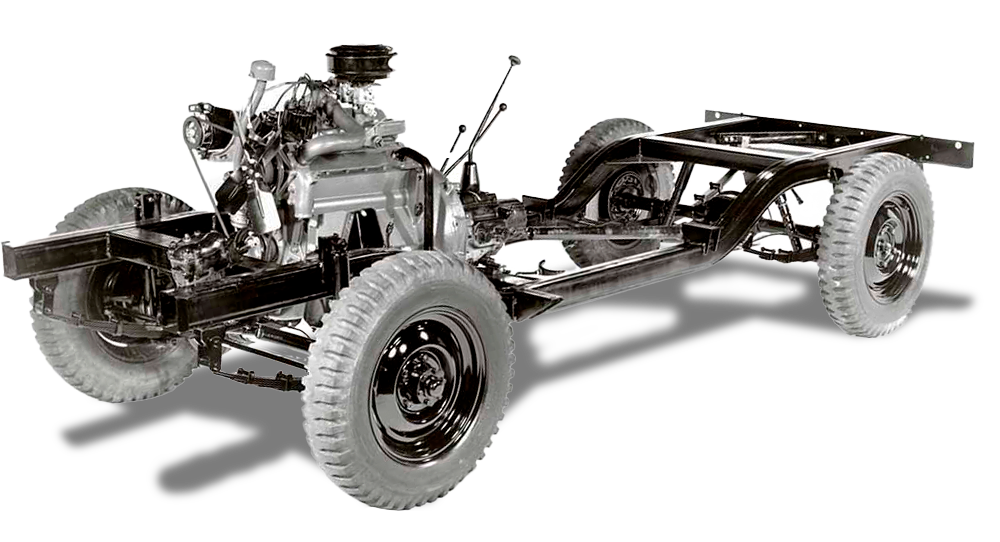 True to the original compact pickup concept, planners biased initial production towards the pickup, many with two-wheel drive. Orders coming in from dealers were overwhelmingly for a four-wheel drive Scout with the full top. If that wasn’t a clue to market preferences, many dealers ordered full tops and retrofitted pickups on the lot. Production quickly reflected those new preferences, but 1961 would represent the highest annual proportion of 4x2s and Cab-Tops in the 19 model years of IH’s Scout vehicles. IH began work almost immediately to bring Scout vehicles closer to customer desires by making it a “true” station wagon with an accessible rear seat. Still, those changes involved substantial body changes that would take time to implement.
True to the original compact pickup concept, planners biased initial production towards the pickup, many with two-wheel drive. Orders coming in from dealers were overwhelmingly for a four-wheel drive Scout with the full top. If that wasn’t a clue to market preferences, many dealers ordered full tops and retrofitted pickups on the lot. Production quickly reflected those new preferences, but 1961 would represent the highest annual proportion of 4x2s and Cab-Tops in the 19 model years of IH’s Scout vehicles. IH began work almost immediately to bring Scout vehicles closer to customer desires by making it a “true” station wagon with an accessible rear seat. Still, those changes involved substantial body changes that would take time to implement.
Despite the shortcomings, Scout vehicle sales continued briskly through 1961 and for the 1962 model year. A frenzy of engineering work blossomed for the 1963 model year in the form of a removable bulkhead so that the Scout vehicle could be configured as either a pickup or wagon on the assembly or converted later by a dealer or owner. Bucket seats, a rear seat, roll-up windows to replace the sliding glass, a much-improved heating system, better sound deadening and powertrain improvements were added as well as a host of new options.
By the middle of 1964, Scout vehicle production was approaching the 100,000 mark… a single-model milestone by IH standards. Stylists and engineers had been working on more ways to spruce up the Scout vehicles. When that 100K benchmark came on July 13, 1964, it was an appropriate segue into an era of the civilized Scout vehicle.
(ABOVE) The most significant course change made in the early years was to bring the Scout upmarket. People want more comfort in their Scouts and the Red Carpet was the first Scout to really deliver on that. The Robinson Family’s restored 1964 Red Carpet shows the significant effort that went into it. Built as a limited production special, it was used to celebrate production of the 100,000 Scout in the summer of 1964. Highlights and firsts in the Red Carpet include the first time chrome bumpers were used on Scout, the first time wheel covers were added, the first time a Scout came with full carpeting, the highest quality upholstery used to date. The Red Carpet came only in white and there were very few available options not included. The “100,000” decal was included but was to be installed by the dealer. Only a small percentage left the dealer lot with them installed so finding an original decal is quite rare.
The Red Carpet Series debuted in July 1964 as the first luxury edition of the Scout vehicle. Internally called a “Doll-Up,” the Red Carpet would set a new course for Scout vehicles, helping it live up to advertising, calling it the perfect combination of a daily driver, second car, hauler and family recreation vehicle. This is the core definition of today’s Sport Utility Vehicle, a term that did not yet exist in 1964 but would come into play very soon. Following the construction of 3,450 Red Carpets in November 1964, the similar Champagne Series followed and carried through the 1965 model year when the Scout 80 model was discontinued. Overall, the Scout 80 model ended on a high note, setting the stage for a big model update.
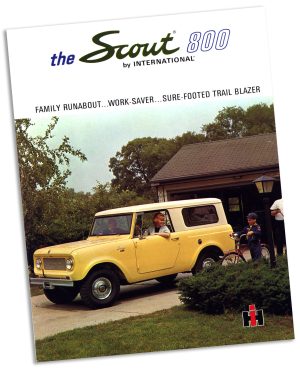 UpMarket- The Scout 800
UpMarket- The Scout 800
The Red Carpet and Champagne Scouts were transitional units pointing the way to deeper changes for 1966 and the new Scout 800™ line. While they shared a similar look and some parts with the Scout 80 vehicle, the Scout 800 vehicles were updated in almost every area. The primary thrust was to make the Scout vehicles more comfortable, civilized, and, dare we say, carlike, but without hampering their ability to work. As part of the updates, IH introduced safety items ahead of new Federal regulations, such as a padded dash, dual circuit brakes, seat belts, lighting improvements, and anti-burst door latches. IH also began work on another generation of Scout vehicles planned for a ’68 or ’69 introduction.
Debuting in the ’66 Scout 800 lineup was a Scout model two giant steps into the style and luxury realm, the Sportop. It was a bold departure from the Scout norm and came with either a slant-backed fiberglass hardtop or a convertible top. Sales-wise, Sportop fell flat on its face. Was it a step too far or a styling faux pas? Opinions differ on that, but it was expensive to make and buy, didn’t sell well, and was discontinued early in 1968. Unsold units clogged inventory into 1969.
Scout models sold well against the Jeep, but in 1966, their first new competition was the Ford® Bronco. Yes, the mighty Ford Motor Company had taken notice of the Scout vehicles. The success of Scout vehicles reportedly inspired Ford to develop the Bronco, which was very similar in execution. IH quickly realized the gigantic Ford Motor Company had the potential to bury the Scout models without working up a sweat. Executive angst ran deep at IH, but fortunately, Ford chose to push the Mustang and not the Bronco. The Bronco cut into Scout vehicle sales, but it was essentially a back burner product at Ford in those years and never delivered a marketing kill shot. Though hampered by tight development budgets, IH engineers and stylists succeeded in keeping Scout models from falling too far off the curve.
(ABOVE) The Sportops had a unique appearance. The hardtop version featured a fiberglass, slant-back roof. The rear windows did not roll down but had a “wing” section that did. The standard interior appointments matched the Custom trim level on the regular Scout. The interior of the convertible was as top drawer as Scout had been up to this time and used a good number of unique trim parts that were expensive to make in small numbers. The build costs vs the low sales is what killed the Sportop. The Sportops had a unique badge/spare tire hubcap that is often missing these days and hard to replace.
One major impact Bronco made was to inspire V8-envy at IH. Bronco debuted with a small six and was soon offered with an optional small V8. IH had a V8 in the pipeline for the next Scout model, called the X-Scout, in development but had yet to plan a V8 for the Scout 800 line. While the big IH 152 and 196 ci fours delivered performance on par with the Bronco’s 170 ci six, the Ford 289 ci V8 was a marketing coup. Development of the X-Scout was slowed to divert enough resources to stuff the IH 266 ci light truck V8 into the Scout 800 line, which became available starting early in 1967.
Progress on the X-Scout was glacially slow, and it would need more time to be ready for ’68 or ’69. Some of the updates planned for the X-Scout were incorporated into the Scout 800 line to keep it fresh. The 1969 Scout 800A line introduced many improvements, including an outside-sourced 232 ci inline six-cylinder to bridge the gap between the base four and the V8. In addition, a larger 304 ci V8 became the top-of-the-line engine, and one of the most frequently requested items, an optional automatic transmission, was also added. Seriously considered but not addressed were power steering and air conditioning. These were held back for X-Scout, but interior appointments took big leaps ahead with the Scout 800A line, both in style and comfort.
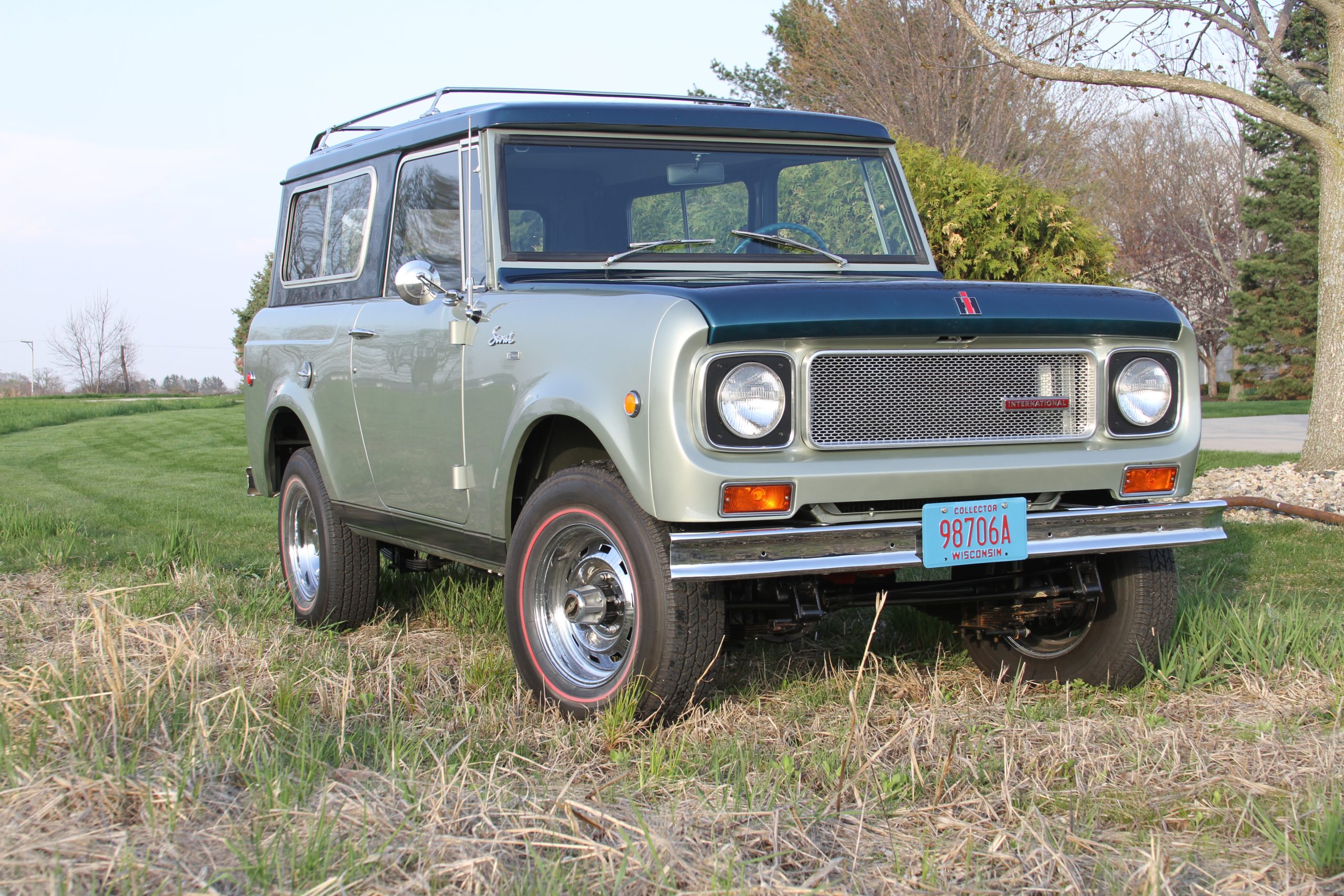
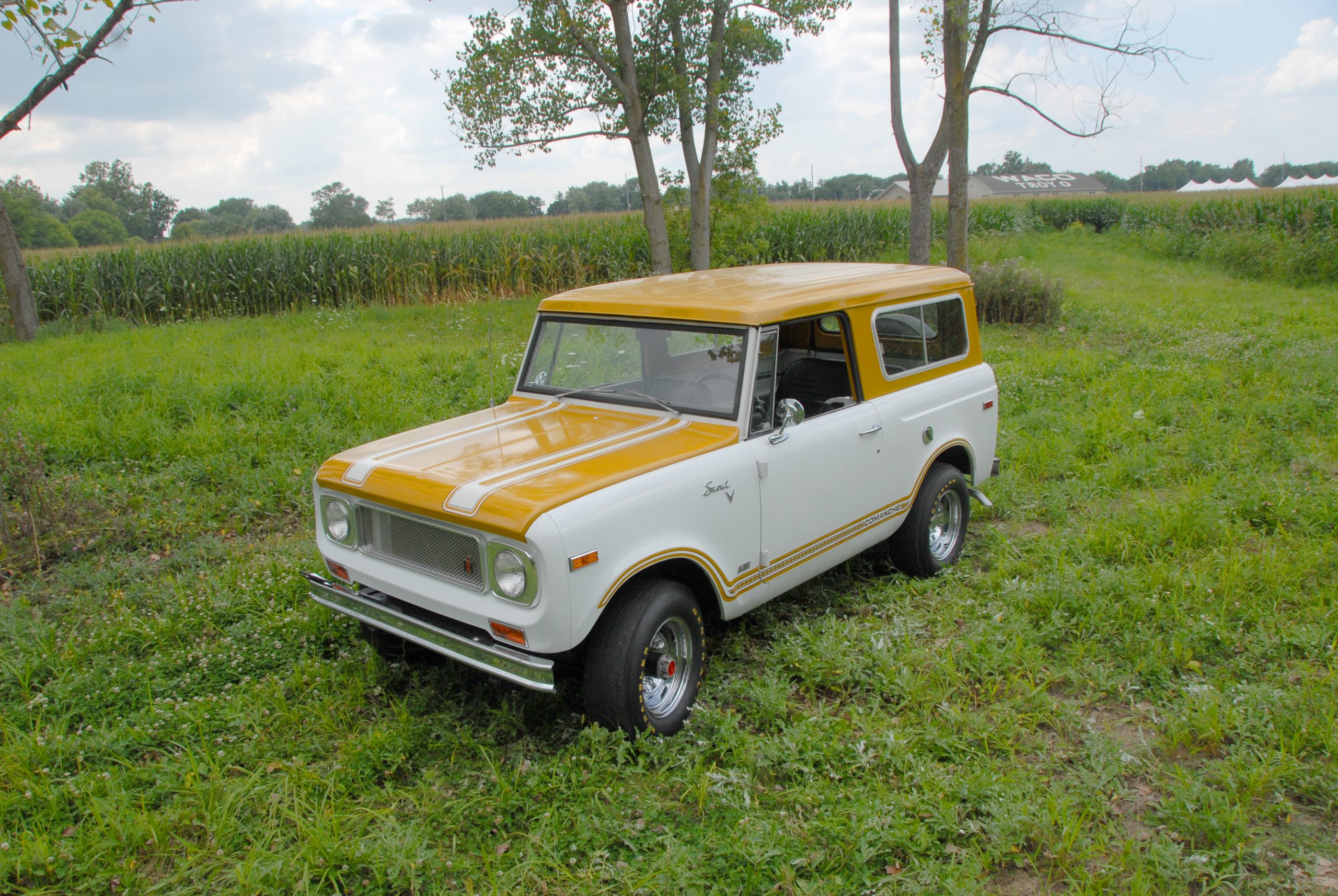
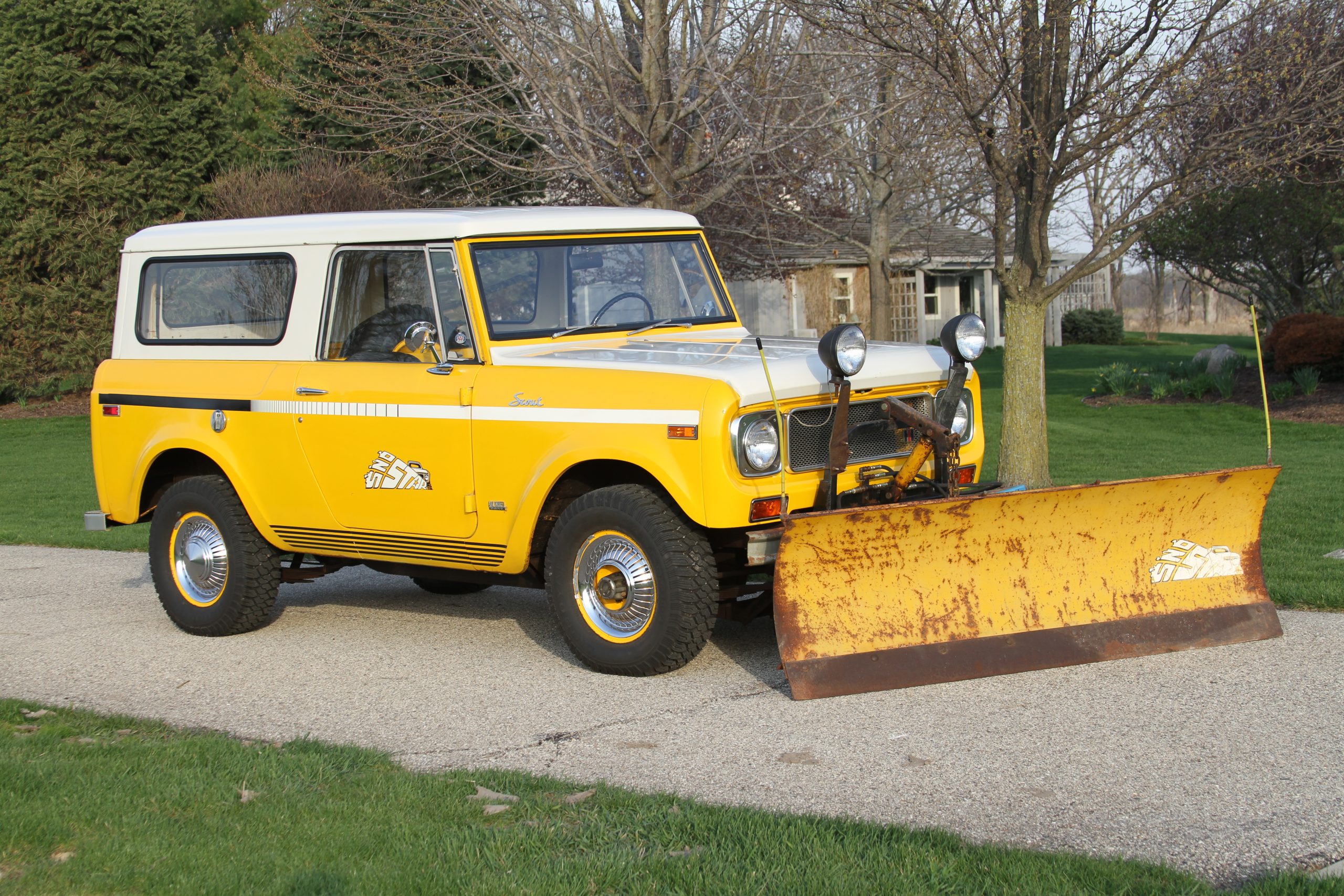
The Aristocrat
The 1969 800A Aristocrat was the vehicle (pun intended) used to launch the optional AMC-sourced 232 six and the Borg-Warner-sourced 3-speed automatic. Introduced March 1, 1969, the Aristocrat was built to the tune of approximately 2,500 units into August of 1969. It was the first time special exterior paint was added to a Scout special model but it wasn't the last. Tom Thayer's superbly restored Aristocrat shows off the Silver and Blue paint combo.
The Comanche
The 800B Comanche in Prairie Gold was originally intended to be one of three color schemes and possible one of three Native American-themed specials. Only about 1,500 of these were completed in the short 800B run and Bob Young's is a totally original survivor, right down to the original General Scrambler tires.
The Sno-Star
The Sno-Star was an 800B era collaboration between IH and the Meyer Snowplow Company. The visuals are appealing, including the special Meyer paint on the body, but the fit-out was basic. The 474 Sno-Stars built featured the Meyer ST-78 6-1/2 foot plow with power angling, the 232 six, automatic trans and a rear limited slip axle with 3.73:1 axle ratios. It didn't have a back seat and a bulkhead was fitted so the various gear needed for plowing could be stowed. A salt spreader was optional. Tom Thayer's unrestored Sno-Star is probably the most perfect and original survivor in the world.






The past success of the Red Carpet and Champagne Series inspired planners to begin the introduction of limited-production special trim packages or “Doll-Ups” in the Scout 800A series. First was the Aristocrat for 1969, a country gentility-themed Scout vehicle. Next came the sporty SR-2 for 1970, in red or gold. Both these models got a great deal of market attention, and sales were good by Scout line standards. This success would not be forgotten.
There had been some hope of introducing the X-Scout in the fall of 1970 in time for a normal 1971 model year intro, but IH needed to do more, and an interim model was needed. Cleverly called the Scout 800B, it was a slightly updated Scout 800A. Yes, it was a stopgap model behind a stopgap model, but IH planted a few nuggets into it. One of those nuggets came in the form of the Comanche, a Native American-themed Scout vehicle that has proved to be one of the most popular and collectible specials in Scoutdom. Another was the Sno-Star™, a stylish snowplow special designed and outfitted in collaboration with the Meyer Snowplow company. Production of the Scout 800B would stop in early March of 1971 to clear the decks for the X-Scout… with the consumer production name, the “Scout II.”
SCOUT II – THE WOW WAGON
In many ways, the extra-long gestation of the Scout II™ model was a benefit. It gave the overworked and understaffed Scout Division more time to get things right. After a short run of preproduction units, the Scout II model debuted to the press in Chandler, Arizona, on April 20-23, 1971, with regular production starting on April 19, 1971. While small numbers of Scout II vehicles arrived at dealers as showroom eye candy, sales numbers didn’t ramp up until the summer when production caught up. Old inventory also needed to be liquidated and the “Wow Wagon” campaign fully implemented.
The Scout II model was almost as big a jump for IH as the original Scout model in 1961. The dated “Frigidaire” styling was obviously gone, but the new beauty was more than skin-deep. The Scout II model debuted with a powertrain lineup that started with the 196 ci four, stepped up to the powerful 232 ci six, a 304 ci V8, and finally, a big 345 ci V8 that beat Ford and tied GM for maximum cubic inches in the 4×4 SUV realm. Power steering, air conditioning, vastly improved ride quality, sound deadening, on top of a broadened array of styling, comfort and convenience options, put the Scout II model right back in the top tier of the growing SUV market. The utility side was not forgotten, and, yes, you could still buy a bare-bones Scout vehicle.
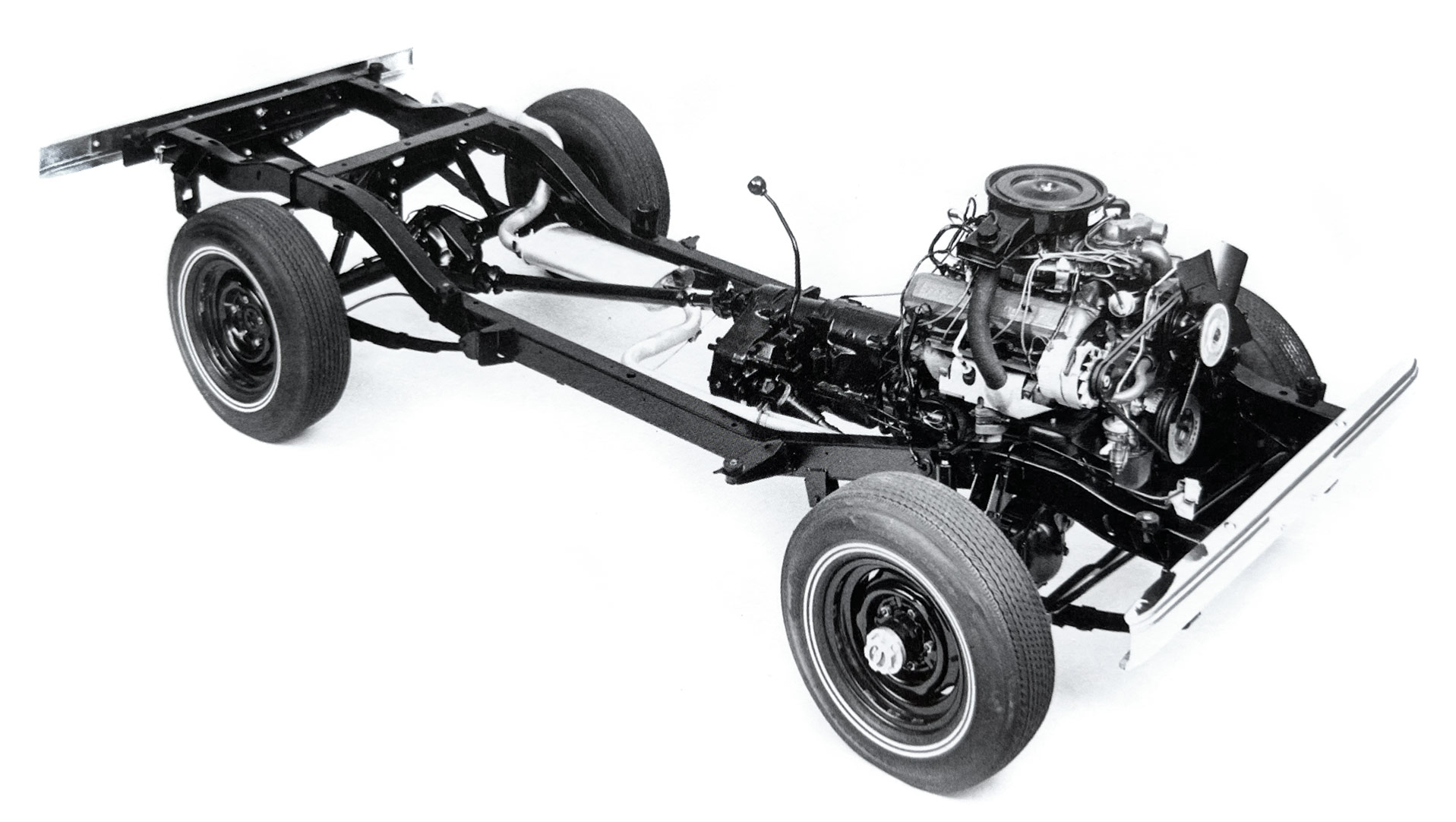
(ABOVE) The Scout chassis consisted of a heavy-gauge, fully boxed chassis that measured 4×3 inches and was made up of 0.120-inch steel with three welded crossmembers. The springs were 56 inches in the rear and 43 inches up front, improving ride quality and higher load capacities. The 4×4 and 4×2 chassis were identical other than the location of the transmission cross-member.
Scout II vehicle sales were nearly everything IH hoped for. A wide range of updates came in the ’72-75 timeframe, including an increasing emphasis on appliques, the IH term for what many now call body graphics. Power disc brakes were introduced for 1974, and powertrain updates kept the Scout vehicle line generally even with the competition. Behind the scenes, things were not so rosy with the parent company, IH.
By the mid-1970s, hard financial times for the country, the fuel crisis, strategic missteps and changing markets had left IH in a pickle. For over 60 years, motor vehicle manufacturing had largely been the icing for an all-things-to-all-farmers company. While the IH medium and heavy truck business was still hopping, the light truck business fell flat. IH made the decision to discontinue light trucks after an abbreviated 1975 model year. The Scout vehicle line was in the crosshairs during this time. Still, some previously planned alterations and updates were seen as a way to keep some of that light truck business and more cost-effectively keep the Scout vehicles in production.
Yes, the range of Scout IIs still included a Cabtop. Jerry Shoop’s 1973 Cabtop is all original down to the Ceylon Green two-tone paint. It has the standard interior and exterior with few options beyond a 304 V8, dual exhaust, automatic transmission, rear limited slip differential and 3.73:1 axle gear ratios. Note that in the Scout II era, “Cab-Top” had been simplified to “Cabtop” and Travel-Top” to “Traveltop.” The white stripe is not factory original and reportedly installed by the dealer.
The 1976 model year brought many updates to the Scout model lineup. Two new long-wheelbase models emerged to partly fill the gaps the departed IH light trucks left. It was an easy engineering job to stretch the Scout vehicle’s 100-inch wheelbase to 118 inches. From there, a base platform could be built out as the Traveler SUV or the Terra pickup by using a removable bulkhead and two types of fiberglass tops. The Traveler basically replaced the Travelall, the light line’s long-running people mover. IH didn’t have the development resources to make Traveler a four-door as the Travelall had been, but it was plenty roomy and had space for three-row seating. The Terra half-ton pickup supplanted the Cabtop Scout II model and offered a six-foot bed. With a 6,200-pound chassis GVRW, it was solidly in the popular half-ton range. But wait, there’s more!
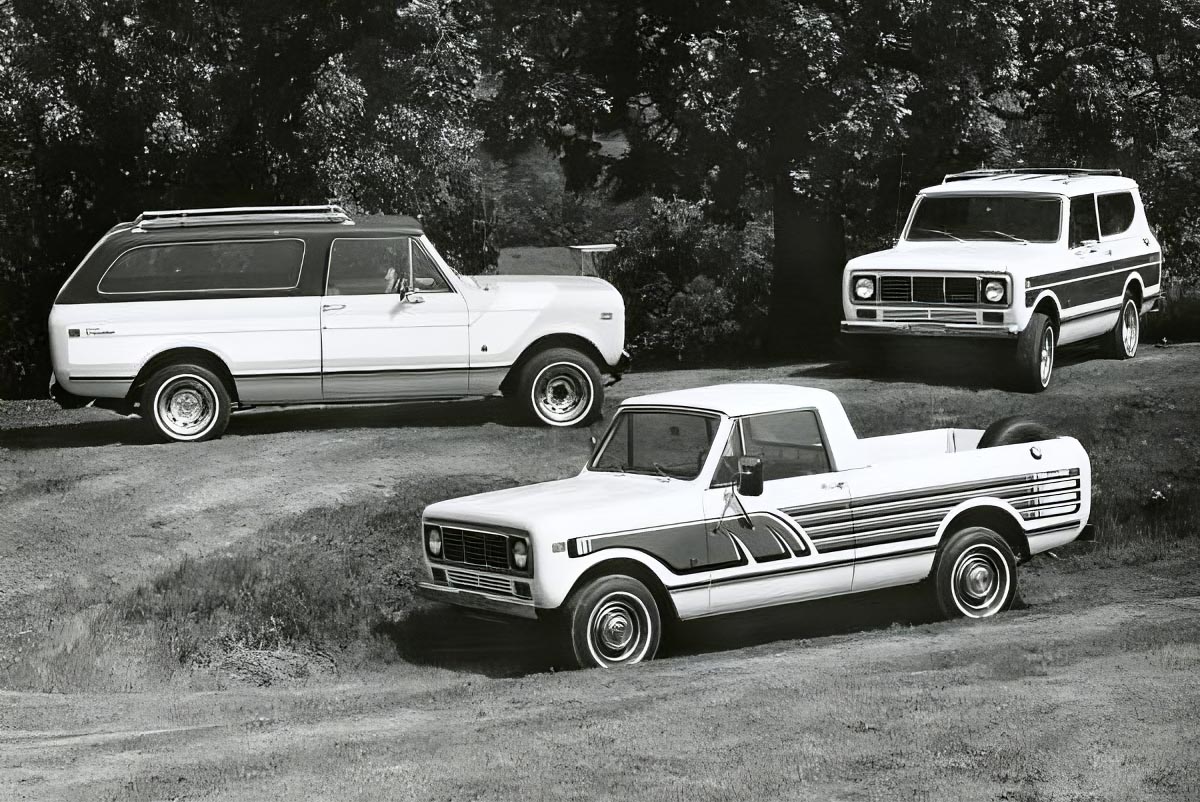
Also introduced for 1976 was the first optional diesel for an American-built SUV. Fuel shortages and high fuel prices had thrown the U.S. auto industry into a tailspin. By government edict and customer demand, the U.S. auto industry had to end the gas-guzzling era in pursuit of increased fuel economy. One of the short-term solutions was the diesel engine, by nature about 30 percent more fuel efficient than an equivalent-displacement gasoline engine. With a small 3.3L diesel added as an option, the Scout model lineup went from 15 mpg with a gasoline four into 20-plus mpg territory with a six-cylinder diesel. Accompanied by weight savings and other improvements, Scout models clawed their way into meeting the new CAFE (Corporate Average Fuel Economy) standards set by the U.S. government. Meeting those standards would always be a problem for IH because, unlike most of its competitors, the Scout model lineup was hampered by an all-truck and SUV lineup. IH offered no cars, especially compact cars, to help raise CAFE fuel standards.

(ABOVE) International Harvester celebrated the United States Bicentennial with several special models, including the Spirit of ’76. It was the first production Scout II to roll off the line with a soft top. It came well equipped for the trail with the first iteration of a big tire package, which consisted of 8×15-inch chrome styled wheels with big 10-15 Goodyear Tracker tires. Under the faux Denim soft top was a roll bar and the interior was in Wedgewood Blue. Winter White with the red and blue accents was the only exterior decor choice. All the standard powertrain options were available.
The following year delivered more Scout whizbangness! Many will know or remember the 1970s as the decade of the van conversion. It was the era of shag carpets, bright colors and far-outness. The Scout vehicle lineup got in on that action, and IH enhanced the 1977 Scout model line by teaming up with Midas Industries to make a series of groovy, upfitted Scout vehicles. Midas, probably best known these days for mufflers and a national chain of auto repair shops, also did van conversions and built RVs in an Elkhart, Indiana, factory. The results were an astounding update to the comfort of the Scout vehicles and the hip status of those driving them. The Midas option proved popular and carried on to the end of Scout vehicle production.
Another milestone for 1977 was the SSII™ model. The late ’60s brought desert racing to the American motorsports consciousness. As with other forms of motorsports, the auto industry soon realized the advertising benefits. The conservative IH was slow to respond, but after a privately entered 1972 Scout II Cabtop won its class in the ’72 Baja 1000, interest was piqued at Fort Wayne. It was still an uphill struggle to convince upper-level execs to sign on. Still, by late in ’76, race teams were contracted to run Scout vehicles in desert racing, and the sporty, Jeep-beating 1977 SSII (for Super Scout™ II) model came along to bolster the trail-capable image. Lean, mean, topless, doorless, and ready to hit the trail, the SSII line became the poster child for the Scout vehicle race teams. While the ’77-79 SSII model was not a big seller, its desert racing connection was a bonanza of mainstream publicity for the Scout vehicle lineup. On top of that, the race Scout vehicles were always in the points and took home a good number of class wins.
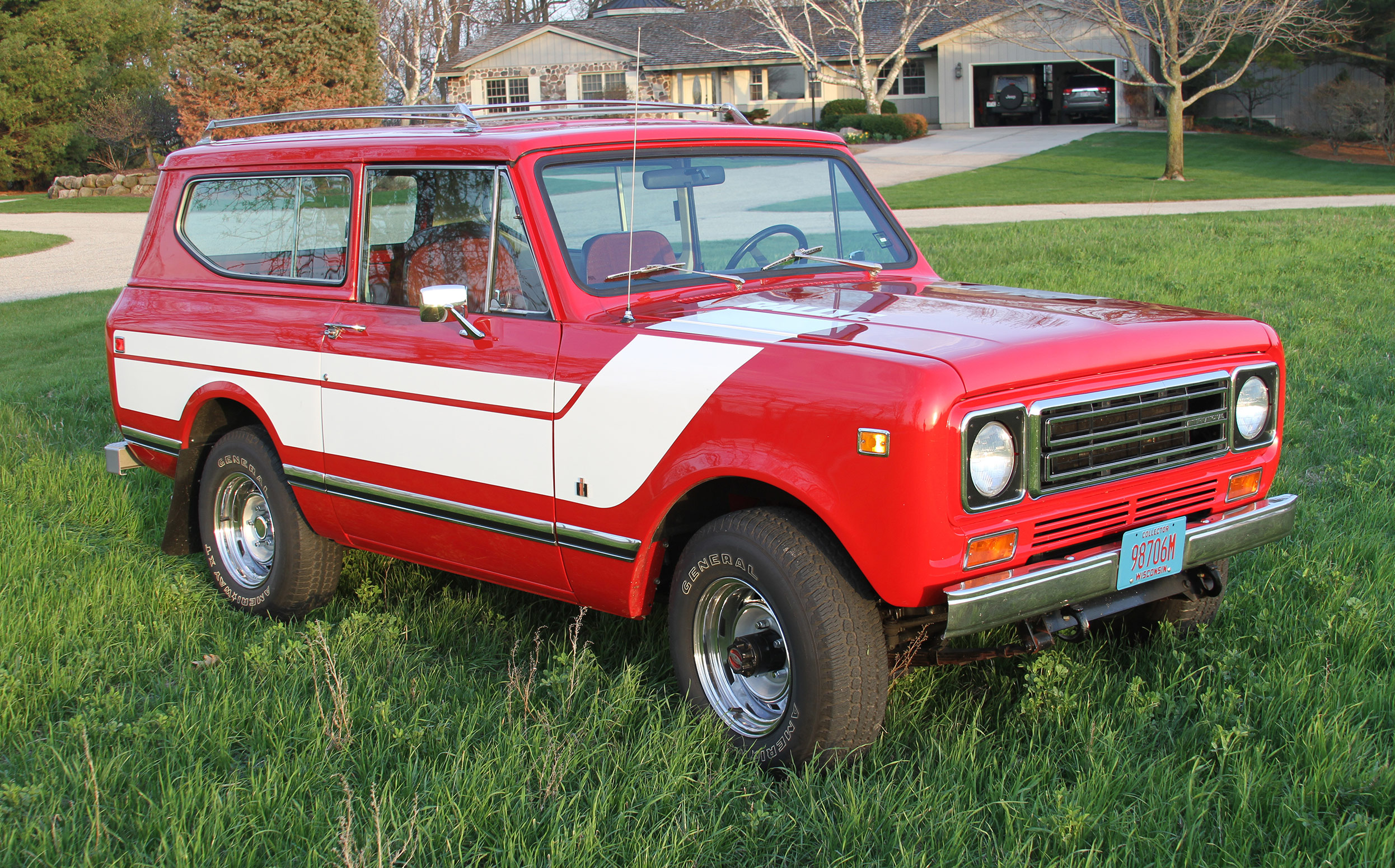
(ABOVE). The Rallye was probably the superstar of Scout II packages and certainly a best seller. It had just the right combination of price, style and functionality. From ’76-79, it included the Rallye applique, the chrome slotted wheels, most commonly known as Rallye Wheels, heavy-duty shock absorbers and power steering. Any power train and interior trim option was possible, though most Rallye Scouts are seen at the higher end of the options food chain. The Rallye applique changed over the years and for 1980, the functional parts, such as the wheels and shocks, became separate options. Shown is Tom Thayer’s ’77 Rallye clone, with all the correct outside pieces.
The Scout II model remained in contention from ’78 through most of ’79 as the SUV market grew by leaps and bounds. In that time, IH had broadened the scope of their graphics packages, lined up another upfitter, Custom Vehicles Incorporated, to build even more stylish special models, and tuned accouterments to reflect the times. IH brought in new mainstream auto marketing professionals and made great inroads to get more Scout vehicles onto Main Street where the general public could see them. IH continued to make concrete plans to move the Scout brand even farther up the curve and there was a lot of optimism in the Scout Division. Dampening all that was IH’s financial trouble, which had expanded into a crisis and, once again, the Scout model lineup had moved into the target area of “not being the core business.”
The 1980 model year was projected to be big, with many upgrades. On the appearance front, a few simple styling changes gave the Scout vehicles a more modern look and the planned updates for ’81-84 were expected going to transform the brand. New, more fuel-efficient, and cleaner running engines were on the horizon. A new platform was in development, and by 1985, the Scout vehicles were destined for a total transformation. Alas, beyond the changes for 1980, none of that would happen.
With 1980 just a month away, financially ailing IH and the United Auto Workers Union initiated a game of “chicken” to negotiate a better contract for the respective side and, for IH, to eliminate red ink. Neither side blinked or swerved, and negotiations dragged on for months. During this period, IH made an internal decision to sell the Scout Division, if possible, or shut it down, if not. While a potential buyer made a lot of noise, a deal never came very close, and Scout vehicle production stopped on October 21, 1980, never to resume. IH would be broken up into several different entities, many of which still survive today. IH’s Scout model lineup would enter the history books, never to be manufactured again.. Then, on May of 2022, the vision and expectation of a new Scout model lineup came to be when Scout Motors arose to create a new generation of Scout vehicles. That story is still being written.
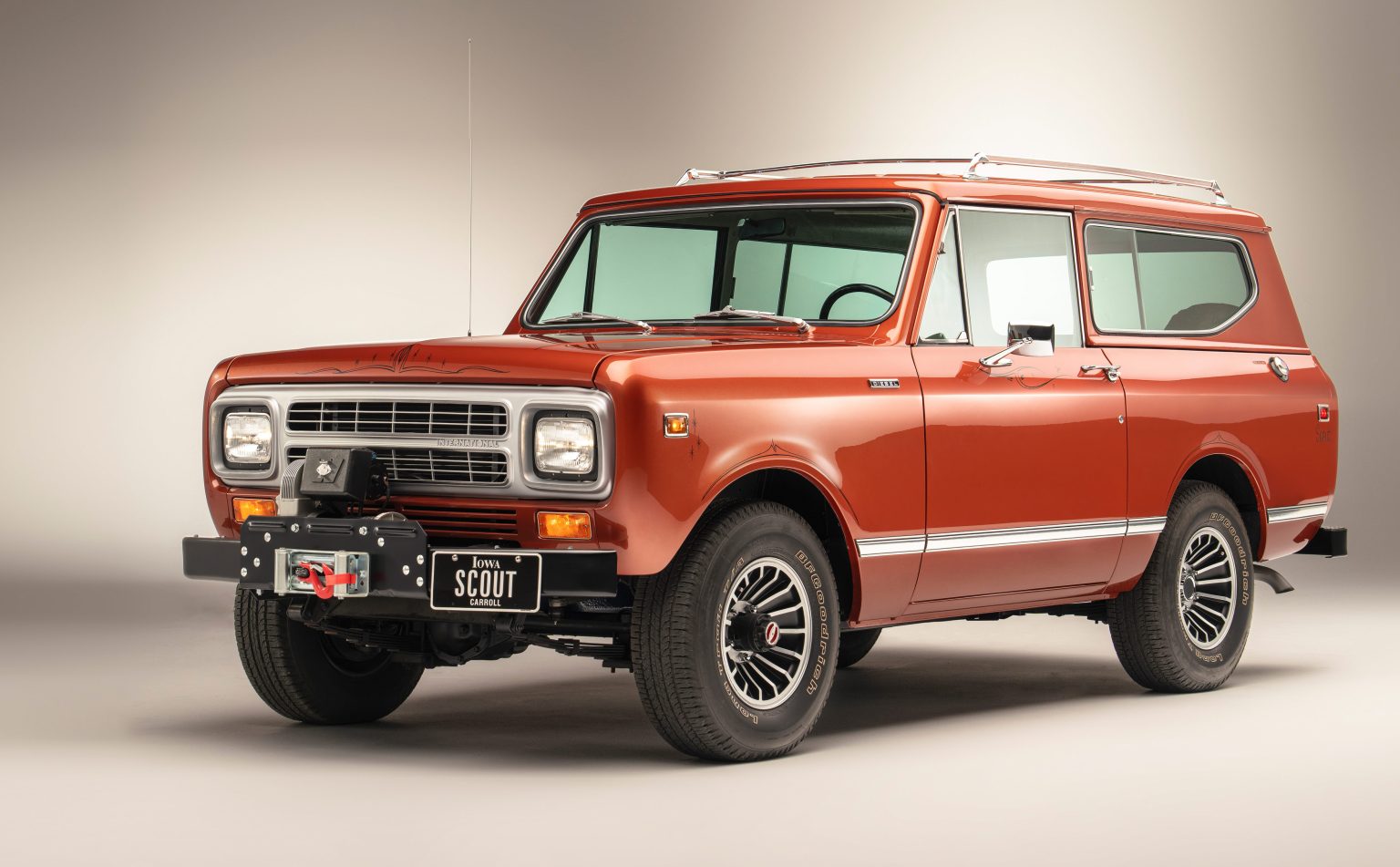
The last scout rolled off the production line on October 21, 1980. It was originally ordered for IH board of directors member, Mary Garst. It stayed in the Garst family until 2003 when Scout historian and collector Mike Bolton purchased it. Years of use as a farm and hunting vehicle meant it needed some TLC and Mike agonized over the decision to fully store the vehicle. In the end Mike spent four and half years completing the painstaking restoration you see here.

